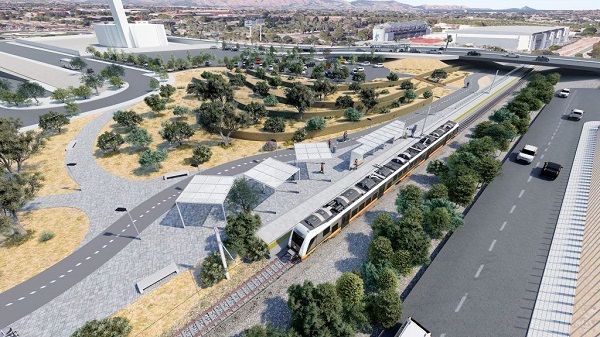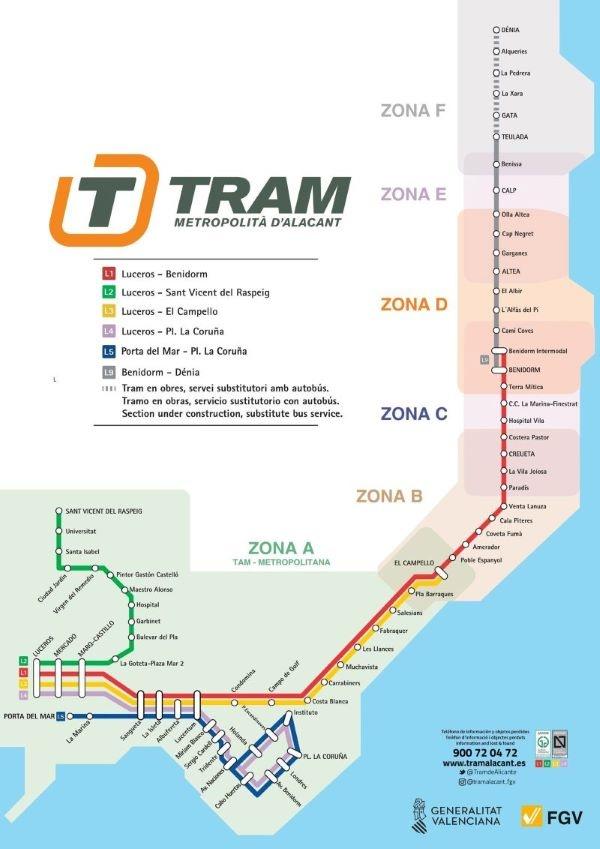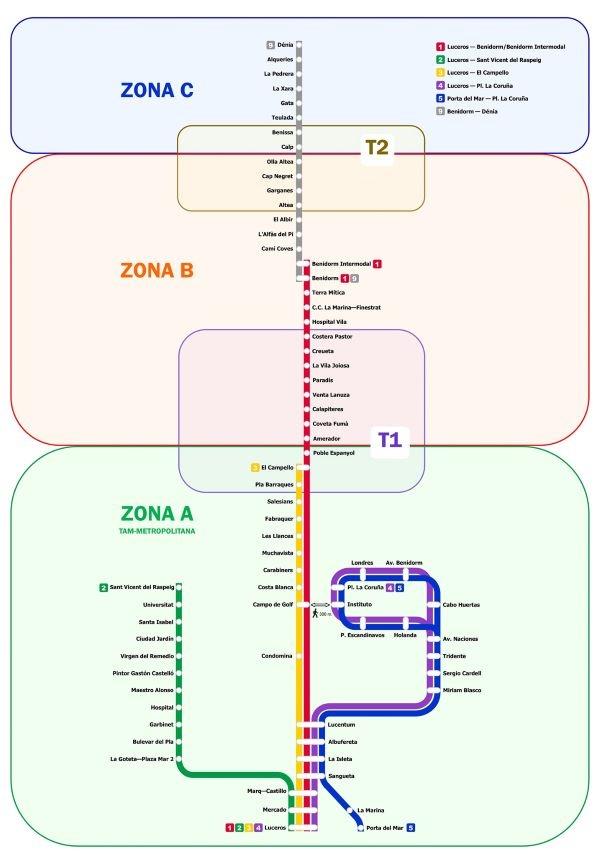Train Service, Alicante to Denia - Routes, Prices and General Information
Train Service Alicante to Denia - One of the reasons that people like to come to Benidorm is that there is always so much to do, but if you feel the need to “stretch your wings” a little and explore the surrounding area nothing could be easier thanks to the local train services.
The trains also known as trams are operated by the local company FGV and have nothing to do with the Spanish Railway (RENFE)
NOTICES
9th April 2024 - Upheaval set to hit line 9
The light railway network which connects Alicante city with Denia will be partially closed on Tuesday (April 9) until December. A bus service will transport passengers on sections of TRAM line 9 while works are being carried out by regional train operator. This work is due to the rail infrastructure around the Mascarat tunnel between Altea and Calpe that was damaged by the wildfire that hit the area in January.
15th August 2023 - Improvement works continue on the tram line between Benidorm and Denia. (Line 9.) It was announced yesterday that the line between Alfaz and Altea is to be "doubled up", with extra track laid over a 3.3 km distance, plus what was described as a "technical passing point" constructed at the Albir stop. These works will enable more frequencies of travel to be applied if needed. The works will cost 14,698,165,43 euros, and the works programmed to take 24 months.
Benidorm’s train station is located at the top of Avenida de Beniardá and, although a good 15-20 minutes' walk inland from the beach, is easily accessed from the tourist side of town on bus number 1 for the standard fare of 1.60€ each way.
Benidorm Intermodal Stop - Located on Avenida de Italia near to the Alsa bus station (Estacion de Autobuses)
When using the Tram Alicante website, you can select the stop of origin and destination, the date and the time range in which you want to travel.
Once the fields have been filled in, the approximate duration and the ticket that will be necessary to complete the journey will be indicated, according to the area to which you want to travel. it will also tell you if it is necessary to carry out any transfers from one line to another.

Train Service Alicante to Denia - General information
| Travel Time (approx.) | |
| Alicante to Benidorm | 1 hour 20 minutes |
| Alicante to Altea | 1 hour 50 minutes |
| Alicante to Calpe | 2 hours 30 minutes |
| Alicante to Denia | 3 hours 10 minutes |
(Please note: Travel times are estimates depending on connections and average waiting time between Tram line changes. )
The trams to Alicante (line 1) leave every half hour starting at 06.35 with the journey taking around 75 minutes. The last tram leaves Alicante to return to Benidorm at 22.11.
The trams on line 1 do not stop at any of the stations between El Campello and Lucentum. If you would like to get off at any of these stations along the beach you need to change at El Campello onto line 3.
And the good news it’s cheap! Return tickets whether to Denia or Alicante, are the same price of just 6.40€ return.
Guide Prices for 2022
Single ticket: 1.45 euros
Multi-trip voucher: 8.70 euros
Bonus 30 days: 26,10 euros
Route voucher 4/30: 15 euros
School TAM voucher: 16.50 euros
TAM jove bonus: 21,20 euros
Train service Alicante to Denia - Zones Map
There are a total of 6 zones:
AREA A: Luceros - Poble Espanyol (metropolitan)
ZONE B: Pla Barraques - Coastal Pastor
AREA C: La Vila - Camí Coves
ZONE D: Terra Mitica - Olla Altea
ZONE E: Altea - Benissa
ZONE F: Benissa - Denia

Line 1: Luceros (Alicante) - Benidorm
The line 1 of the TRAM connects the central Plaza de Los Luceros with Benidorm. The total length of the route is 43 km. In this line the 4100 units circulate, they are trains that reach 100km / h and that combine sections in tram regime and others with railway platform. In Benidorm there is a link with the L9 line with final destination Denia.
The Alicante - Benidorm connection has a total of 20 intermediate stations. From Luceros you reach El Campello quite quickly and from there numerous stops occur before arriving in Benidorm.
The connection Benidorm - Alicante is one of the most used transport methods. From the Benidorm stop located at Crta. Estació , the tram of line 1 leaves every half hour approximately. The full tour until arriving in Alicante lasts approximately one hour and is done along the coast, overlooking the beach during much of the trip.
There are 4 tram stations in Alicante and which one you get off at depends on what you want to do.
SANGUETA - the best station if you want to go to the beach, marina and Esplanada. It is about 10 minutes walk along by the beach. The branch line (4L) down to the beach at Puerta del Mar was closed down in 2013 so Sangueta is now the nearest station to the beach.
MARQ-CASTILLO if you want to go to Castillo Santa Barbara. This is also the stop to get off to visit the acclaimed archaeological museum - a great place to visit on a wet day!
MERCADO for the area around the indoor market or a walk down the Rambla to Esplanada.
LUCEROS - the end of the line (so no worry about missing your stop) - is best for shopping etc. This is right in the centre of the city.
Train service Alicante to Denia
Line 2: Luceros (Alicante) - Sant Vicent del Raspeig
The line 2 TRAM is the most commonly used alicantinos and connects the Plaza de los Luceros the center of San Vicent del Raspeig line. It travels a total of 9 km. It completes in about 25 minutes. The step frequencies are approximately 8 minutes at rush hour. The trains are 4200 units, designed to circulate in urban environments, which reach 70 km / h.
On its way it passes through the Market, the Marq, the Pla neighborhood, the general hospital, Virgen del Remedio, Ciudad Jardín and Universidad.
Line 3: Luceros (Alicante) - El Campello
The line 3 TRAM connects Alicante with El Campello in a path that runs parallel to the coast, passing through San Juan and Muchavista. The route has 14.5 km. They are completed in about 25 minutes. It has a frequency of 20 minutes at rush hour and 30 minutes.
Line 4: Luceros (Alicante) - San Juan Beach
The Line 4 of the TRAM connects the city center with the districts of the albufereta, Barrio de las Huertas and Playa San Juan. The trains are 4200 units, since it is an entirely urban route line. Its passing frequency is about 30 minutes.
Line 5: Puerta del Mar - Plaza de La Coruña
TRAM Line 5 connects the waterfront of the city of Alicante, with Albufereta Beach, San Juan Beach and Cabo de las Huertas. It has its stop in front of Playa del Postiguet, at Puerta del Mar.
This new line has a connection at the Lucentum stop with L1 and L3, and at Sangueta stop with L1, L3 and L4.
In principle it will work from June to October, as a reinforcement to Line 4 during the summer period. Depending on the demand and use during these summer months the rest of the year will last.
Line 9: Benidorm - Denia
The line 9 connects Benidorm with the capital of Alta, Denia Marina. Its frequency is one train every hour.
Things to note:
Inside the tram are illuminated signs which indicate the next stop, there is usually also a verbal announcement, a good chance to improve your pronunciation of Spanish towns.
When on the tram, signal to the driver you wish the tram to stop at the next stop - Press the button on the door - note the button and a sign in the carriage illuminate when this has been done.
Pressing the same button will open the doors when the tram has stopped.
On the tram - no smoking.
Do not travel without a shirt on.
Animals - It is not allowed to travel with animals, except: Assistance dogs for people with disabilities or with their training instructors. Dogs accompanying the security forces. Small pets in cages or carriers.
You can buy your return ticket at Benidorm station ticket office. There are machines on the trams, but they are not very easy to understand. There is an on the spot fine of €50 for not having a ticket.
The single ticket is for immediate use. You must validate it within 30 minutes from the moment of purchase.
You cannot use the “transfer” option to make a trip in the opposite direction with the same ticket.
It is important to retain your tram ticket for the duration of your journey. You will need to scan it at the end of our journey to exit the turnstiles at Alicante Luceros, Mercado or MARQ stations.
Toll-free number for information and Customer Service (900 72 04 72).
They don’t have toilets! So perhaps it’s a good idea not to have 15 pints of beer before you set off! Have fun!
LOST AND FOUND
If you lose something in our facilities, please call our Customer Service Centre at 900 72 04 72 where you will be asked to give a brief description of the lost object. If your object has been found, we will inform you on how to get it back. Unclaimed Objects Objects found and not claimed within five weeks will be handed over to:
Alicante City Hall Lost and Found
Avda. Don Julián Besteiro, 15 03008 - Alicante Tfno. 965149969
Disabled Facilities on the Tram
All tram stops, trains and trams are adapted for people with reduced mobility problems and for passengers in wheelchairs.
The underground stations have automatic stairs and are equipped with elevators - specially designed for people with mobility problems - that connect the lobbies with the public thoroughfare and the platforms.
At all stops there are ramps to make it easier for people in wheelchairs to access the units from the platforms.
Note about wheelchairs, electrics and scooters
Wheelchairs, for the purposes of the regulations (RD 1544/2007, of November 23 and its published modification of September 20, 2019), are understood to be that support product for the mobility of people included in the object and field of application of the following rules:
a) Wheelchairs with manual propulsion. According to the UNE-EN 12183 standard.
b) Wheelchairs with an electric motor and scooters with an electric motor with three or more wheels. According to the UNE-EN 12184 standard, and that they can be included in Classes A and B, or in Class C as long as it complies with the dimensions and manoeuvring area established for Class B. Maximum dimensions of length and width are, respectively, 1,300 per 700mm
LINK HERE TO THE TRAM WEBSITE FOR TIMES ETC
15th March 2022 New Zones planned - The new zonal distribution allows to move from six to three zones and is working in a coordinated way to expand the TAM zone
New zonal map

The new tariff regulation includes a simplification of the zonal distribution of the TRAM d'Alacant by moving from the current six zones to three zones, plus two inter-county transition areas to avoid the rigidity of the zonical borders.
Currently, the six existing tariff zones give place to 21 possible zonal combinations and six different tariffs, depending on the number of areas traveled on a ferry. With the modification proposed, the three areas would correspond to the three districts for which the TRAM d'Alicant is circulating: L'Alacantí, Marina Baixa and Marina Alta.
With the new distribution of the TRAM d'Alacant the Zone A would cover the stops located in the municipal terms of Alicant, Sant Vicent del Raspeig and El Campello, to which the future expansion of the network would be added in the municipalities of Sant Joan and Mutxamel.
However, until the expansion of the TAM area is completed, through the agreement with the other administrations involved, the stops of Amerador, Coveta Fumá, Cala Pitres and Venta Lanuza, belonging to the municipal term of El Campello, p they will remain integrated in Zone B.
Zone B would understand the stops of the municipalities of La Vila-joiosa, Benidorm, L'Alfàs del Pi and Altea, while Zone C would be integrated by the municipalities of Calp, Teulada, Gata de Gorgos, Benissa and Dénia.
Another novelty that presents the new structure is the inclusion of two inter-district transitions, which are established between Pla Barraques and Costera Pastor, in the south, and between Altea and Benissa in the north. Travels that take place between stops of each of these sections would have consideration for traveling made in a single area.
In the proposed model, there are only 6 possible zonal combinations depending on the trip made and, only three applicable fares: of one, two or three areas in which the 10-travel bonus will cost 8 euros, 12 euros and 20 euros, respectively very much.
Examples by municipalities
With the new zonal plan and the new fares that have been approved by the FGV Board of Directors and that will apply from the summer, for example, a person who wants to travel from the Lucentum stop in Alicante, to Benidorm or whatever to make a journey from El Albir to Dénia, it will start moving by two areas, instead of the current three. This will mean a 42% discount of the price of the Bonus 10, which will go from €21 to €12.
People wanting to travel from Sant Vicent del Raspeig to Altea will travel through the four current areas to travel for two. This will give them a 55% discount starting summer; and they will go from paying €27.20 to €12.
Travel between Gata de Gorgos and Calp will cost, starting in the summer, 42% less, taking as a reference Bono 10, as they will move through one area and not the two current areas. Similarly, people who want to move from Dénia to Benidorm or viceversa will also see how the areas they move are reduced, which will cost them a savings of 42%.
Ultimately, there will also be areas that will benefit from a drop in prices, although in the future they will pass through the same number of areas. For example, the neighbours of El Campello who want to move to Hospital Vila will continue to pay two areas, but the price of the Bonus 10 of two areas will go from 14 euros to 12 euros.


